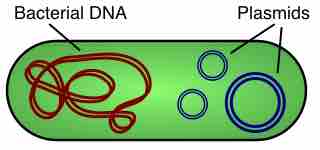In molecular biology, a vector is a DNA molecule used as a vehicle to transfer foreign genetic material into another cell. The four major types of vectors are plasmids, viral vectors, cosmids, and artificial chromosomes. Common to all engineered vectors are an origin of replication, a multicloning site, and a selectable marker.
The vector itself is generally a DNA sequence that consists of an insert (transgene) and a larger sequence that serves as the "backbone" of the vector. The purpose of a vector which transfers genetic information to another cell is typically to isolate, multiply, or express the insert in the target cell. Vectors called expression vectors (expression constructs) are specifically for the expression of the transgene in the target cell, and generally have a promoter sequence that drives expression of the transgene. Simpler vectors called transcription vectors are only capable of being transcribed but not translated: they can be replicated in a target cell but not expressed, unlike expression vectors. Transcription vectors are used to amplify their insert.
Insertion of a vector into the target cell is usually called transformation for bacterial cells, and transfection for eukaryotic cells, although the insertion of a viral vector is often called transduction.
Plasmids are double-stranded generally circular DNA sequences that are capable of automatically replicating in a host cell . Plasmid vectors minimalistically consist of an origin of replication that allows for semi-independent replication of the plasmid in the host and also the transgene insert. Modern plasmids generally have many more features, notably including a "multiple cloning site" which includes nucleotide overhangs for insertion of an insert, and multiple restriction enzyme consensus sites to either side of the insert.
In the case of plasmids utilized as transcription vectors, incubating bacteria with plasmids generates hundreds or thousands of copies of the vector within the bacteria in hours. The vectors can be extracted from the bacteria, and the multiple cloning sites can be cut by restriction enzymes to excise the hundredfold or thousandfold amplified insert. These plasmid transcription vectors characteristically lack crucial sequences that code for polyadenylation sequences and translation termination sequences in translated mRNAs, making protein expression from transcription vectors impossible.
Plasmids may be conjugative / transmissible and non-conjugative. Conjugative vectors mediate DNA transfer through conjugation and therefore spread rapidly among the bacterial cells of a population, such as the F plasmid, as well as many R and some col plasmids. Non-conjugative vectors do not mediate DNA through conjugation, such as many R and col plasmids.
Viral vectors are generally genetically-engineered viruses carrying modified viral DNA or RNA that has been rendered noninfectious, but still contain viral promoters and also the transgene. This allows for the translation of the transgene through a viral promoter. However, because viral vectors are frequently lacking infectious sequences, they require helper viruses or packaging lines for large-scale transfection. Viral vectors are often designed for permanent incorporation of the insert into the host genome, and thus leave distinct genetic markers in the host genome after incorporating the transgene. For example, retroviruses leave a characteristic retroviral integration pattern after insertion that is detectable and indicates that the viral vector has incorporated into the host genome.
